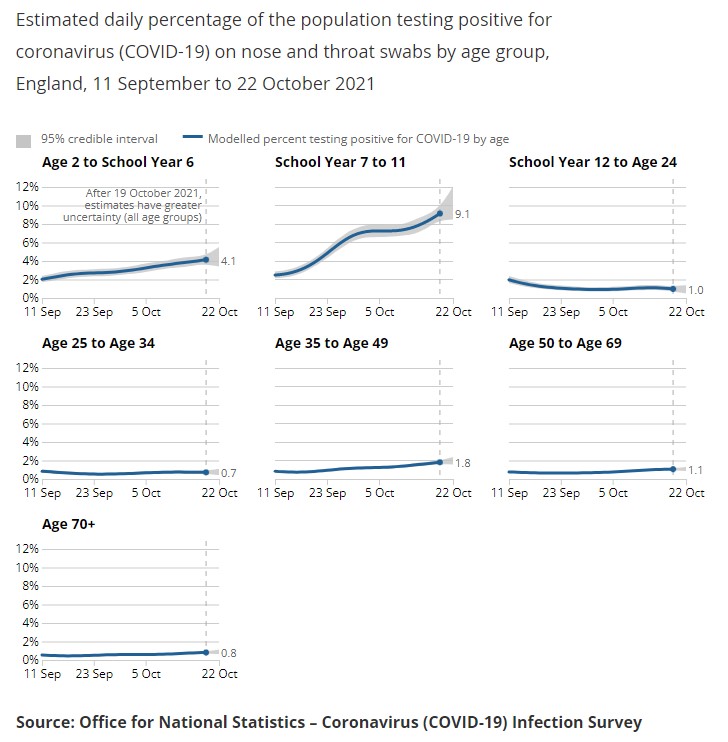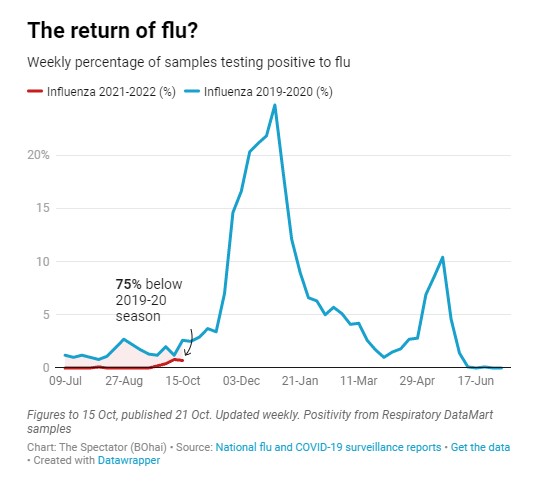As reported daily infections fall once again, giving a temporary reprieve from calls for social restrictions to be re-imposed, the new ONS Infection Survey data published today shows record levels of prevalence in the country in the two weeks ending October 22nd.

One in 50 people in England or 2% of the population are estimated to have had coronavirus during that fortnight. In Wales it was around 2.5% or one in 40.
Importantly, this recent epidemic is almost exclusively in children, especially those aged 11-16, and to a lesser extent in their parents (aged 35-49). Prevalence in primary school children rose to around 4.1% by October 22nd while in secondary school children it was 9.1% or one in 11.

Since then reported infections in children have begun to fall, leading some experts to declare that, with an estimated 75% of the cohort now having been infected, “England has seen the peak of cases in children“.
Modelling for the Government is now predicting a persisting slump in infections going into the winter, with some estimates envisaging as few as 5,000 daily reported infections by Christmas.
This puts me in the unexpected position of being more pessimistic than SAGE, as I would be frankly amazed if there was no winter surge in Covid infections. We’ve seen before how SAGE models seem not to take sufficient account of seasonality, and this may be another example of that.
We learned last winter that it doesn’t help sceptics not to anticipate surges. We don’t want to be in the position where the Government’s resistance to lockdowns depends on these unusually rosy predictions of a Covid-free winter coming to pass. Besides, if Covid did abandon us this winter more than likely there would be some other seasonal virus to take its place.
The epidemic since June has been mostly in the young, initially in students and young adults, and latterly in those under 16. Oddly, the ‘freshers’ flu’ and university outbreaks that usually occur in September and October and dominated autumn 2020 are missing this year, at least with Covid. This autumn it’s been the turn of school children to have an epidemic, and just like last year, it has declined as we head into November – though this time the Government did not allow itself to be bumped into a lockdown (though not for lack of trying on the part of the health establishment).
What will the winter bring? There’s still no new variant emerging anywhere, but winter has always brought waves of respiratory illness. Take a look at the curve for flu in 2019-20 below. Big surge around the end of November, and then sudden sharp decline from the end of December, just like Covid in winter 2020-21.

You can really see the effect of the January 2020 lockdown to cut flu transmission there. What’s that you say – there was no lockdown in January 2020? But why then did infections suddenly plummet? I’m sure Neil Ferguson can tell me.
Winter will almost certainly bring its usual respiratory viral epidemic, and it’s still likely to be Covid this year. The NHS needs to be ready for that, though hopefully the vaccines will limit mortality (something potentially thrown into doubt by the recent Swedish study suggesting declining effectiveness against severe disease). But no, of course we shouldn’t lock down or re-impose restrictions on people because of this entirely foreseeable and expected eventuality.
If we’re still a free people somewhere under all this madness, we need to stop thinking that winter flu bugs are a reason to smother our social, cultural and economic life. It’s not good for our health.











To join in with the discussion please make a donation to The Daily Sceptic.
Profanity and abuse will be removed and may lead to a permanent ban.